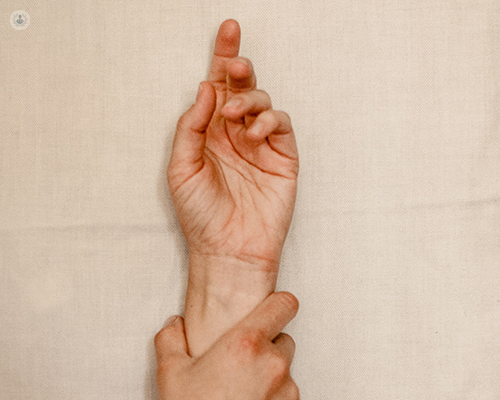Carpal tunnel syndrome FAQs answered by a specialist
Written by:Carpal tunnel syndrome is a common condition that causes sensations of pins and needles along with numbness in the hand and wrist. Naturally, there are numerous frequently asked questions people have about carpal tunnel upon diagnosis or when considering they, or someone they know, has the condition. In this article, Mr Andrew Logan, a consultant orthopaedic surgeon who specialises in the hand and wrist, answers the most frequently asked questions regarding carpal tunnel syndrome.

What is carpal tunnel syndrome?
Carpal tunnel syndrome is the collection of symptoms and signs associated with compression of the median nerve in the wrist. The median nerve is one of the nerves in the hand responsible for one area of the hand’s sensation and it also controls some of the hand’s muscles. It’s classically responsible for the feeling in the thumb, index finger, middle finger and the half of the ring finger that faces the middle finger.
Where does the name come from?
The carpal tunnel itself is an actual tunnel in the wrist through which the tendons (tissues that attach muscle to a bone) run from the forearm to the fingers and the median nerve from the forearm to the hand. The tendons are also surrounded by a layer of tissue that allows them to glide smoothly past each other when the fingers are moved. The name ‘carpal’ refers to the bones of the wrist (the carpal bones) that make up part of the tunnel.
What causes it?
In all but a small number of cases, it is not known why patients develop carpal tunnel syndrome. The tunnel has a set size in each individual and if the contents of the tunnel become too much for the size of the tunnel, then the pressure inside the tunnel increases. This pressure then squashes the median nerve in the tunnel and can stop the nerve from working properly. In turn, this then affects the area of sensation and muscles that the nerve is responsible for. For example, it can cause weakness in the muscles around the base of the thumb.
In most cases, we do not know why the volume of the contents in the tunnel increases enough to cause the nerve to be squashed.
Why is the rest of the hand not affected?
The rest of the hand isn’t affected by carpal tunnel because the nerves that supply sensation to the rest of the hand don’t pass through the tunnel.
What are the typical symptoms?
The most common symptom is usually a mixture of pins and needles and numbness in the thumb, index finger, middle finger and half of the ring finger. The symptoms may be constant or can come and go, and are typically worse at night time and when gripping something e.g. holding a book or a phone, or the steering wheel while driving. Patients can also get an ache in the wrist and the affected fingers and this ache can be quite severe. Weakness of the muscles is usually rare, but it can occur in more severe cases.
Can I prevent myself from getting it?
As it is not fully understood why most patients get carpal tunnel syndrome, there is nothing that can be done to prevent it.
How is it diagnosed?
With a typical pattern of symptoms and an examination by a specialist, most cases can be diagnosed in the outpatient clinic. If the symptoms and examination are not typical, the patient will be referred for nerve tests. These tests can tell the specialist if the median nerve is being compressed in the carpal tunnel.
How is it treated?
In cases where most of the symptoms happen at night, a simple night splint may be all that is needed. This can be effective because carpal tunnel syndrome is made worse when the wrist is flexed (a common sleeping position for the wrist) and the splint keeps the wrist straight while you sleep.
A steroid injection into the carpal tunnel can relieve the symptoms. Most injections do wear off with time, but they can be repeated if the relief lasts a reasonable amount of time.
The long term treatment for troublesome carpal tunnel syndrome is an operation under local anaesthetic. Approximately three-quarters of the diameter of the carpal tunnel is made up of the carpal (wrist) bones. The final part of the tunnel’s diameter is a ligament, the transverse carpal ligament. During carpal tunnel surgery, a 3 cm cut is made in the palm at the level of the wrist. The transverse carpal ligament is then cut. Cutting this ligament makes the tunnel wider. This gives more room for the contents of the tunnel and reduces the pressure in the tunnel and the pressure on the nerve.
View Mr Logan’s profile to learn how he can help you with your hand and wrist ailments and to arrange your face-to-face or online consultation.


